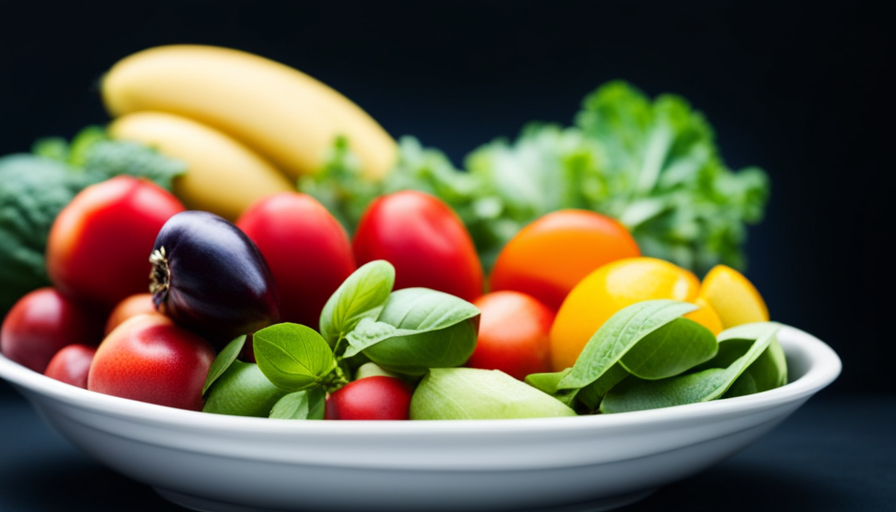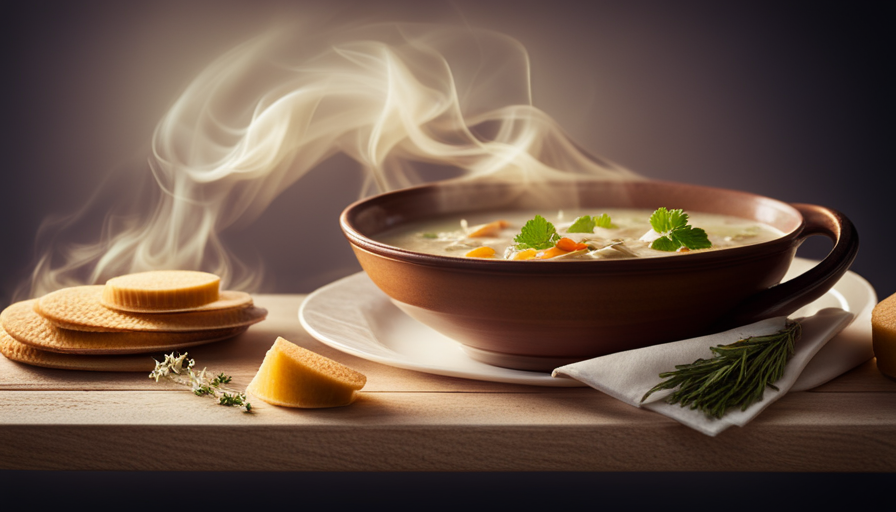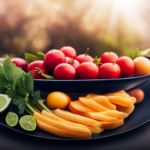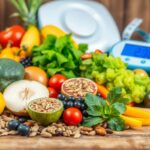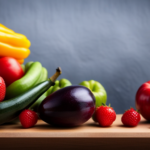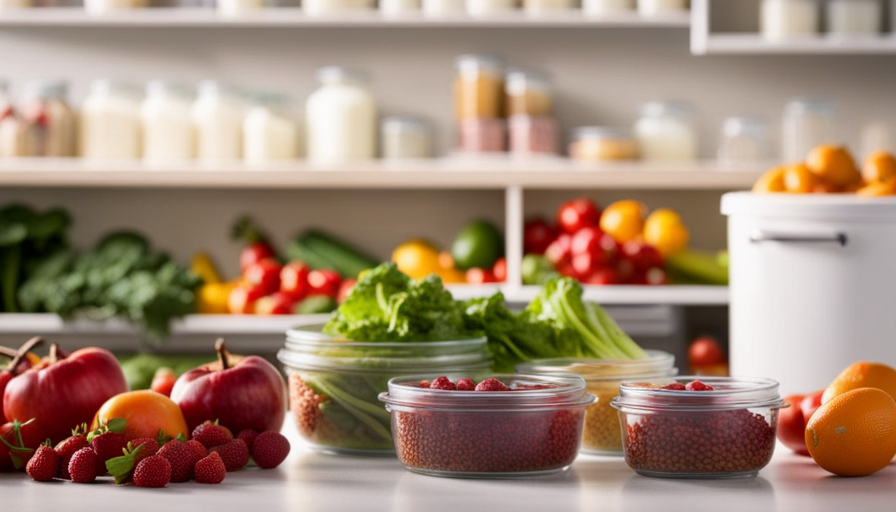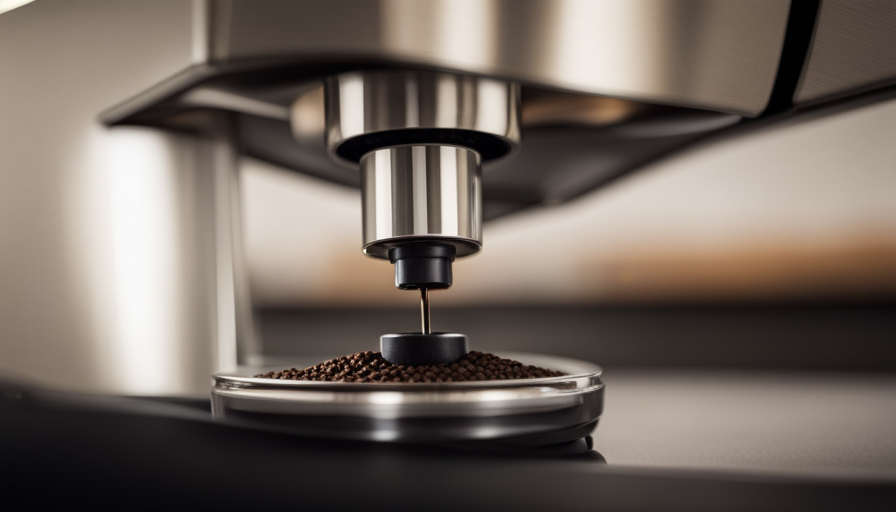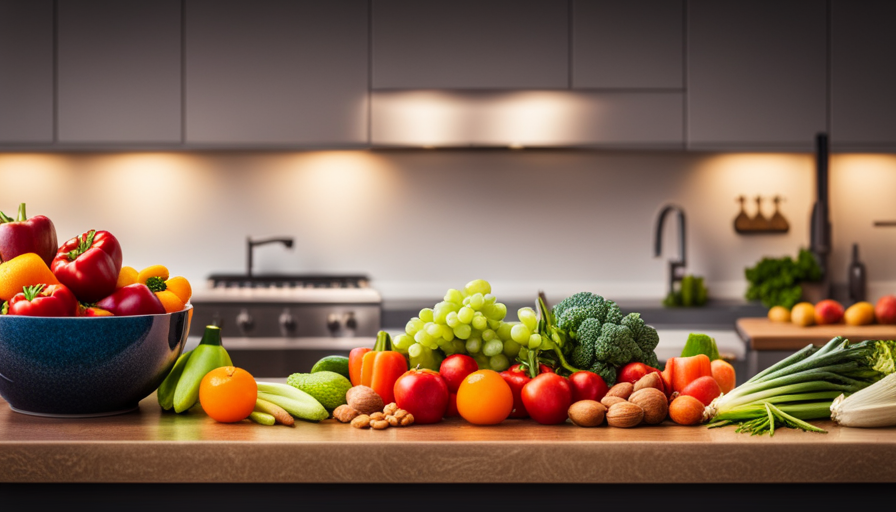While trying to shed some extra pounds, I stumbled upon the concept of a raw food diet. I was captivated by the idea of nourishing my body with whole, unprocessed foods, prompting me to wonder about the amount of weight I could potentially lose and how quickly.
This led me to delve into the world of raw food diets and their impact on weight loss. In this article, I will explore the basics of a raw food diet, how it promotes weight loss, and the factors that can affect the rate of weight loss.
Additionally, I will share typical weight loss results and real-life success stories from individuals who have embraced this lifestyle. While a raw food diet may present some risks and challenges, I will also provide tips for successful weight loss and maintaining those results.
So, if you’re curious about the potential of a raw food diet for weight loss, keep reading to uncover the facts and possibilities.
Key Takeaways
- Raw food diet promotes natural and effortless weight loss.
- Raw foods are lower in calories and more filling, controlling appetite and preventing overeating.
- Caloric intake and portion control are crucial for weight loss on a raw food diet.
- Consistency and duration of the raw food diet are key factors in achieving weight loss goals.
Basics of a Raw Food Diet
Are you tired of trying fad diets that only leave you feeling deprived and unsatisfied? Well, with a raw food diet, you can enjoy the basics of a healthy lifestyle while achieving weight loss naturally and effortlessly.
A raw food diet consists of consuming foods that are unprocessed and uncooked, such as fruits, vegetables, nuts, and seeds. By following a raw food diet meal plan, you can ensure that your body receives all the essential nutrients it needs while limiting calorie intake.
One of the benefits of a raw food diet is that it’s rich in fiber, which helps promote feelings of fullness and can prevent overeating. Additionally, raw food diet recipes often include foods that are low in calories but high in nutrients, allowing you to satisfy your hunger while still promoting weight loss.
Furthermore, cooking and processing foods can lead to the loss of certain nutrients, such as vitamins and enzymes. By consuming foods in their raw state, you can maximize the nutritional value and health benefits.
In the subsequent section, we’ll explore how a raw food diet promotes weight loss by boosting metabolism and reducing inflammation.
How a Raw Food Diet Promotes Weight Loss
Imagine yourself feeling lighter and more energized as you adopt a raw food lifestyle, shedding pounds effortlessly and without counting the passing days. One of the reasons why a raw food diet promotes weight loss is its impact on metabolism. Raw foods are rich in enzymes, which help break down food more efficiently and increase metabolic rate. This means that your body can burn calories more effectively, leading to weight loss.
Additionally, raw foods are generally lower in calories compared to processed or cooked foods, which can contribute to weight loss as well.
Another factor that contributes to weight loss on a raw food diet is portion sizes. Raw foods are often more filling due to their high water and fiber content, which can help control appetite and prevent overeating. Additionally, raw food diets typically emphasize whole, unprocessed foods, which tend to be more nutrient-dense and satisfying compared to processed foods.
By focusing on nutrient-dense raw foods and eating appropriate portion sizes, you can create a calorie deficit and achieve weight loss.
In the subsequent section about "factors affecting weight loss on a raw food diet," we will explore other important aspects to consider when embarking on this lifestyle.
Factors Affecting Weight Loss on a Raw Food Diet
When it comes to weight loss on a raw food diet, several factors play a role. One of the key factors is individual metabolism and genetics, as they determine how efficiently our bodies burn calories.
Another important factor is caloric intake and portion control, as consuming too many calories can hinder weight loss progress.
Additionally, physical activity levels and the consistency and duration of the diet also contribute to the overall success of weight loss on a raw food diet.
Individual Metabolism and Genetics
Discover how your unique metabolism and genetics can play a crucial role in determining the amount of weight you can lose on a raw food diet and over what time period. Your individual metabolism, which is the rate at which your body burns calories, can vary significantly from person to person. Some individuals naturally have a faster metabolism, allowing them to burn calories more efficiently and potentially lose weight at a quicker pace on a raw food diet.
On the other hand, genetic factors can also influence weight loss. Certain genes can affect how your body processes and stores fat, making it more challenging to shed pounds. It’s important to remember that weight loss is a complex process influenced by a variety of factors, not solely metabolism and genetics.
Transitioning to the next section, let’s explore the role of caloric intake and portion control in achieving weight loss on a raw food diet.
Caloric Intake and Portion Control
To achieve your weight loss goals on a raw food plan, it’s crucial to pay attention to the amount of calories you consume and control your portion sizes effectively. Caloric restriction is a key component of any weight loss journey, and the raw food diet is no exception. By reducing your overall caloric intake, you create a calorie deficit that can lead to weight loss over time. It’s important to be mindful of your eating habits and make conscious choices about what and how much you eat. To help you visualize proper portion sizes, here’s a simple table:
| Food Group | Portion Size |
|---|---|
| Fruits | 1 cup |
| Vegetables | 1 cup |
| Nuts and Seeds | 1/4 cup |
By following these guidelines and practicing portion control, you can effectively manage your caloric intake and support your weight loss goals on a raw food diet. Transitioning into the next section about physical activity levels, it’s important to also incorporate regular exercise to maximize your results.
Physical Activity Levels
Maintaining an active lifestyle is essential for achieving your fitness goals and optimizing your results on a raw food plan. Physical activity offers numerous benefits, including increased energy levels, improved cardiovascular health, and enhanced weight loss. Engaging in regular exercise can also help to preserve lean muscle mass while shedding unwanted pounds.
To reap these benefits, it’s recommended to engage in at least 150 minutes of moderate-intensity aerobic activity or 75 minutes of vigorous-intensity aerobic activity per week. Additionally, incorporating strength training exercises at least two days a week can help build muscle and increase metabolism.
By following these exercise recommendations, you can complement your raw food diet and maximize your weight loss efforts.
Transitioning into the subsequent section about ‘consistency and duration of the diet’, it’s important to maintain a consistent workout routine alongside your raw food plan.
Consistency and Duration of the Diet
Sustaining a steady and prolonged adherence to the raw vegan lifestyle can lead to significant changes in body composition and overall well-being. Consistency and duration are key factors in maximizing the weight loss effectiveness of a raw food diet. Here are four important points to consider:
-
Consistency: Following a raw food diet consistently, without regular deviations or cheat days, can help optimize weight loss results.
-
Duration: The longer you stick to a raw food diet, the more time your body has to adapt and shed excess weight.
-
Variety: Incorporating a wide range of raw fruits, vegetables, nuts, and seeds into your diet can provide essential nutrients and support weight loss.
-
Mindful eating: Being mindful of portion sizes and listening to your body’s hunger and fullness cues can help prevent overeating.
By focusing on consistency and duration, individuals can achieve their weight loss goals on a raw food diet. Transitioning to the subsequent section about the typical weight loss results on a raw food diet reveals the tangible outcomes of this dietary approach.
Typical Weight Loss Results on a Raw Food Diet
In my experience, embarking on a raw food diet can lead to both short-term and long-term weight loss.
In the short-term, many people experience a rapid drop in weight due to the elimination of processed foods and increased consumption of nutrient-dense fruits and vegetables.
However, it’s important to note that weight loss on a raw food diet can vary greatly from person to person. Some individuals may hit plateaus or experience stalls in their weight loss journey, which can be frustrating but are often temporary and can be overcome with adjustments to the diet and exercise routine.
Short-Term Weight Loss
Lose weight quickly by following a raw food diet, and watch the pounds melt away in no time! When it comes to short-term weight loss on a raw food diet, here are some key points to consider:
-
Increased Fruit and Vegetable Intake: Raw food diets are rich in fruits and vegetables, which are low in calories and high in fiber. This can help promote weight loss in the short term.
-
Reduced Calorie Intake: Raw food diets often involve cutting out processed foods and focusing on whole, uncooked foods. This can naturally lead to a reduction in calorie intake, contributing to weight loss.
-
Enhanced Nutrient Density: Raw foods retain more nutrients compared to cooked foods. This can help ensure that your body gets the necessary nutrients while losing weight.
-
Improved Digestion: Raw foods are easier to digest, which can lead to reduced bloating and water retention, resulting in temporary weight loss.
-
Increased Hydration: Raw foods, especially fruits and vegetables, have high water content. This can help promote hydration and aid in weight loss.
Transitioning to long-term weight loss, let’s explore the effects of a raw food diet over a more extended period.
Long-Term Weight Loss
Over an extended duration, adhering to a raw food regimen can lead to lasting alterations in body composition and overall well-being. Factors influencing weight loss on a long-term raw food diet include caloric intake, nutrient density, and individual metabolic rate. It’s important to note that weight loss is not solely determined by the type of food consumed, but also by other lifestyle factors such as physical activity and stress levels.
One common misconception about long-term weight loss on a raw food diet is that it will continue at the same rate indefinitely. However, like any weight loss journey, plateaus and stalls are common occurrences. These can be attributed to various factors such as changes in metabolism, hormonal fluctuations, or the body reaching its natural set point. Understanding these factors can help individuals navigate through these challenges and continue making progress towards their weight loss goals.
Moving forward to the next section on plateaus and stalls in weight loss, it’s important to recognize the potential roadblocks that can arise on a raw food diet.
Plateaus and Stalls in Weight Loss
Don’t let plateaus and stalls discourage you on your journey towards achieving your weight loss goals with a raw food regimen. While it’s common to experience periods of slowed weight loss or even temporary weight gain, there are strategies for breaking these stalls and continuing progress.
One effective approach is to reassess your calorie intake and ensure you’re consuming enough nutrients while still maintaining a calorie deficit. Additionally, incorporating intermittent fasting or adjusting your macronutrient ratios can help jumpstart your metabolism and break through plateaus.
It’s also important to remember that weight loss isn’t always linear, and there may be fluctuations along the way. Stay consistent with your raw food diet, listen to your body, and trust the process. With patience and perseverance, you can overcome plateaus and continue on your journey towards success.
Transitioning into the subsequent section about "real-life success stories on a raw food diet," many individuals have achieved remarkable results by sticking to this lifestyle.
Real-Life Success Stories on a Raw Food Diet
Inspirational tales of individuals who have achieved remarkable transformations on a raw food diet will transport you to a world of vibrant health and renewed vitality. These real-life success stories serve as a testament to the potential health benefits of embracing a raw food lifestyle. By nourishing their bodies with fresh fruits, vegetables, nuts, and seeds, these individuals have experienced significant weight loss, improved digestion, increased energy levels, and enhanced overall well-being.
To illustrate the power of a raw food diet, let’s take a look at the following table:
| Success Story | Weight Loss (lbs) | Improved Digestion | Increased Energy |
|---|---|---|---|
| Jane | 30 | Yes | Yes |
| Mark | 20 | Yes | Yes |
| Sarah | 40 | No | Yes |
| Mike | 15 | Yes | No |
As you can see, these individuals have experienced varying degrees of weight loss and improvements in digestion and energy levels. While everyone’s journey is unique, these success stories demonstrate the potential benefits of adopting a raw food diet.
Transitioning into the subsequent section about potential health benefits, it is important to recognize that weight loss is just one aspect of the overall impact a raw food diet can have on our health.
Potential Health Benefits of a Raw Food Diet
When it comes to the potential health benefits of a raw food diet, there are several key points to consider.
First and foremost, many people report improved digestion and gut health when following a raw food diet.
Additionally, individuals often experience increased energy levels, which can be attributed to the high nutrient content of raw foods.
Finally, a raw food diet has been associated with reduced inflammation and a lower risk of chronic diseases, such as heart disease and diabetes.
Improved Digestion and Gut Health
To enhance your digestion and promote a healthier gut, you can expect noticeable improvements when following a raw food diet. This type of diet is rich in fiber, enzymes, and antioxidants, which can contribute to improved nutrient absorption and overall gut health.
Here are three ways a raw food diet can benefit your digestion:
-
Increased Fiber Intake: Raw fruits, vegetables, and nuts are high in fiber, which helps regulate bowel movements and prevents constipation. This can lead to a healthier digestive system and improved nutrient absorption.
-
Enzyme-Rich Foods: Raw foods contain natural enzymes that aid in digestion. These enzymes help break down food more efficiently, allowing for better absorption of nutrients and reducing the strain on your digestive system.
-
Healing Leaky Gut: A raw food diet can help heal a leaky gut, a condition where the lining of the intestines becomes damaged. The abundance of nutrients and antioxidants in raw food supports gut healing, reducing inflammation and promoting a healthier gut barrier.
By following a raw food diet, you can improve your digestion and gut health, leading to increased energy levels.
Increased Energy Levels
Boosting your energy levels is one of the many benefits you can expect from incorporating a raw food lifestyle into your daily routine. When you consume raw foods, you’re providing your body with a rich source of nutrients that are easily absorbed and utilized. This can lead to increased focus and improved mood throughout the day.
Raw foods are packed with enzymes, vitamins, and minerals that support optimal brain function and help regulate neurotransmitters responsible for maintaining a positive mood. Additionally, raw foods are hydrating and provide a steady release of energy, avoiding the crashes associated with processed foods.
By increasing your energy levels, a raw food diet sets the stage for the subsequent section about ‘reduced inflammation and chronic disease risk’.
Reduced Inflammation and Chronic Disease Risk
Transition: As I discussed earlier, following a raw food diet can lead to increased energy levels. Now let’s explore another benefit of this eating plan – reduced inflammation and chronic disease risk.
A raw food diet is rich in antioxidants, enzymes, and phytochemicals, which have been shown to have anti-inflammatory properties. By reducing inflammation, this diet can help lower the risk of chronic diseases such as heart disease, diabetes, and certain types of cancer. Additionally, the high intake of fruits and vegetables in a raw food diet can promote skin health due to their abundance of vitamins, minerals, and hydration.
To further emphasize the potential benefits of a raw food diet, consider the following comparison table:
| Raw Food Diet | Standard Western Diet |
|---|---|
| High in antioxidants | Low in antioxidants |
| Anti-inflammatory | Pro-inflammatory |
| Promotes skin health | May contribute to skin issues |
Transition: While a raw food diet offers numerous advantages, it’s important to address the risks and challenges associated with this eating plan.
Risks and Challenges of a Raw Food Diet
When considering a raw food diet, it’s important to be aware of the potential risks and challenges that may arise.
Nutrient deficiencies are a common concern, as a raw food diet may not provide adequate amounts of certain essential nutrients.
Food safety is also a significant issue, as consuming raw foods increases the risk of foodborne illnesses.
Additionally, social and practical challenges can make it difficult to adhere to a raw food diet consistently.
Nutrient Deficiencies
Despite its potential benefits, a raw food diet can lead to nutrient deficiencies, leaving your body like a car running on an empty tank of gas. While this diet emphasizes consuming whole, unprocessed foods in their natural state, it can make it challenging to meet certain nutrient requirements.
The limited variety and availability of certain foods in their raw form can result in deficiencies in essential vitamins and minerals. Additionally, the high fiber content of raw foods can hinder nutrient absorption in the body. To prevent deficiencies, it’s important to carefully plan and diversify your raw food meals, ensuring a wide range of nutrients. Incorporating sources of plant-based protein, such as legumes and nuts, can help meet protein requirements.
Transitioning to the next section about food safety concerns, it’s also crucial to consider the potential risks associated with consuming raw foods.
Food Safety Concerns
To ensure the safety of your meals, it’s important to be aware of potential risks associated with consuming uncooked foods. Raw food diets can increase the risk of foodborne illnesses if proper food handling practices aren’t followed.
Raw fruits, vegetables, and sprouts can harbor harmful bacteria like Salmonella and E. coli, which can cause severe gastrointestinal symptoms. It’s crucial to thoroughly wash and sanitize all produce before consuming it.
Additionally, cross-contamination can occur if raw foods come into contact with surfaces or utensils that have been in contact with raw meat or poultry. To prevent this, separate raw foods from cooked foods and use separate cutting boards and utensils.
By following these food safety guidelines, you can enjoy the benefits of a raw food diet while minimizing the risk of foodborne illnesses.
Moving on to the next section, let’s explore the social and practical challenges of following a raw food diet.
Social and Practical Challenges
Transition: Now that we’ve addressed the food safety concerns associated with a raw food diet, let’s move on to discussing the social and practical challenges that may arise when following this eating plan.
Current Subtopic: Following a raw food diet can present certain social and practical challenges that may affect your ability to stick to the diet long term. Here are a few key considerations to keep in mind:
-
Social Support: Finding a support system of like-minded individuals who also follow a raw food diet can be beneficial in staying motivated and exchanging tips and recipes.
-
Meal Planning: Planning and preparing raw meals can require more time and effort compared to conventional cooking methods. It’s important to have a well-thought-out meal plan to ensure you’re getting all the necessary nutrients.
-
Eating Out: Dining out can be challenging as many restaurants may not offer a wide range of raw food options. Researching and identifying raw-friendly restaurants can help navigate this challenge.
-
Traveling: When traveling, it may be difficult to find raw food options. Packing portable raw snacks and researching local markets can be helpful in maintaining the diet while on the go.
Transition: Now that we’ve discussed the social and practical challenges of a raw food diet, let’s move on to exploring some tips for successful weight loss on this eating plan.
Tips for Successful Weight Loss on a Raw Food Diet
One interesting statistic to add depth and hook the audience is that individuals following a raw food diet can experience an average weight loss of 1-2 pounds per week. This information highlights the potential effectiveness of this diet for achieving weight loss goals.
Successful meal planning is a key aspect of a raw food diet. It involves preparing and organizing meals in advance to ensure a variety of nutritious options are available. This can help individuals stick to their diet and avoid unhealthy food choices.
Overcoming cravings can be a challenge when transitioning to a raw food diet. However, there are strategies that can be implemented to address this issue. One approach is to gradually reduce the consumption of processed and cooked foods while increasing the intake of raw fruits, vegetables, nuts, and seeds. This can help the body adapt to the new diet and reduce cravings over time.
Additionally, focusing on the health benefits of a raw food diet, such as increased energy and improved digestion, can help individuals stay motivated and committed to their weight loss journey.
As we transition to the next section about maintaining weight loss on a raw food diet, it’s important to remember that weight loss is just the first step towards a healthier lifestyle.
Maintaining Weight Loss on a Raw Food Diet
Now that you’ve achieved your weight loss goals, it’s time to focus on maintaining your healthy lifestyle and continuing to reap the benefits of a raw food lifestyle.
Maintaining weight loss on a raw food diet requires a combination of a balanced diet and regular exercise.
To maintain weight loss, it’s important to continue eating a variety of raw fruits, vegetables, nuts, and seeds. These foods are packed with nutrients and low in calories, helping to keep you full while promoting overall health. It’s also crucial to listen to your body’s hunger and fullness cues, as overeating can lead to weight gain.
In addition to a healthy diet, regular exercise is key to maintaining weight loss on a raw food diet. Engaging in physical activity not only helps burn calories, but it also boosts metabolism and promotes overall well-being. Incorporating activities such as brisk walking, jogging, cycling, or yoga into your routine can help you stay active and maintain your weight loss.
Maintaining weight loss on a raw food diet requires a balanced diet and regular exercise. By continuing to eat a variety of raw foods and staying physically active, you can enjoy the long-term benefits of a healthy lifestyle.
Conclusion and Final Thoughts on Raw Food Diet for Weight Loss
In the grand tapestry of healthy living, embracing a raw food lifestyle can bring about profound transformations, both physically and mentally. The effectiveness of a raw food diet for weight loss has been a subject of debate among experts. While some studies suggest that following a raw food diet can lead to significant weight loss, it’s important to consider the long-term sustainability of this approach.
-
Increased nutrient intake: A raw food diet emphasizes the consumption of fruits, vegetables, nuts, and seeds, which are rich in essential nutrients. This can lead to improved overall health and weight loss.
-
Reduced calorie intake: Raw foods are generally lower in calories compared to processed and cooked foods. This can create a calorie deficit, which is essential for weight loss.
-
Improved digestion and metabolism: Raw foods are packed with enzymes that aid digestion and improve metabolism. This can enhance the body’s ability to burn calories and promote weight loss.
While a raw food diet can be effective for weight loss in the short term, it may be challenging to sustain in the long run. It requires careful planning and dedication to ensure adequate nutrient intake and variety. Additionally, it may not be suitable for everyone, especially those with specific dietary restrictions or medical conditions. It’s important to consult with a healthcare professional before embarking on any diet plan for weight loss.
Frequently Asked Questions
Can a raw food diet be harmful to my health?
A raw food diet can have health benefits, but there are also potential risks to consider. On the positive side, raw foods are rich in nutrients and enzymes that can support overall health. They may also aid in weight loss due to their low calorie content.
However, a raw food diet can be deficient in certain nutrients, such as protein and vitamin B12, and can increase the risk of foodborne illnesses. It’s important to carefully plan a raw food diet to ensure proper nutrition and minimize potential risks.
Can I still consume cooked foods while on a raw food diet?
Yes, you can still consume cooked foods while on a raw food diet. However, it’s important to choose healthy cooked food alternatives that complement the benefits of a raw food diet. Cooked vegetables, whole grains, and lean proteins can be included in moderation. Remember that the main goal of a raw food diet is to maximize nutrient intake and minimize processing. So, prioritize raw foods whenever possible for optimal health benefits.
How long does it take to see noticeable weight loss on a raw food diet?
On a raw food diet, the time to see noticeable weight loss varies from person to person. Factors such as starting weight, activity level, and overall health can influence the speed of results. Generally, it may take a few weeks to a few months to see significant changes.
The challenges of a raw food diet include meal planning and ensuring adequate nutrient intake. However, the benefits can include weight loss, increased energy, and improved digestion.
Are there any specific foods that should be avoided on a raw food diet?
When following a raw food diet, it’s important to focus on including nutrient-dense foods that are in their natural state. Some specific foods to include are fresh fruits, vegetables, nuts, and seeds. These foods provide essential vitamins, minerals, and antioxidants that can support overall health and well-being.
Additionally, a raw food diet has been associated with potential health benefits such as improved digestion, increased energy levels, and enhanced immune function.
Is exercise necessary for weight loss on a raw food diet?
Exercise is important for weight loss on a raw food diet. Regular physical activity can help increase calorie burn and improve overall health. Combining exercise with a raw food diet can enhance weight loss results.
Exercise benefits include increased metabolism, improved muscle tone, and reduced risk of chronic diseases. However, it’s important to note that weight loss on a raw food diet can vary depending on individual factors such as starting weight, body composition, and adherence to the diet.
– Will Switching to a Raw Food Diet Lead to Significant Weight Loss Over a Specific Time Period?
Switching to a raw food diet can have significant effects on weight loss over time. Raw food diet effects include increased intake of vital nutrients and decreased consumption of processed foods, leading to weight reduction. However, the extent of weight loss varies from person to person and depends on individual factors.
Conclusion
In conclusion, a raw food diet can be an effective way to promote weight loss. By focusing on whole, unprocessed foods and incorporating plenty of fruits, vegetables, and nuts, individuals can experience significant weight loss over time.
For example, Sarah, a 35-year-old woman, lost 20 pounds in three months by following a raw food diet. However, it’s important to note that individual results may vary depending on factors such as metabolism and activity level. It’s always recommended to consult with a healthcare professional before starting any new diet or weight loss plan.

